Accept all cookies Accept only essential cookies See our Cookie Notice

About ESA
The European Space Agency (ESA) is Europe’s gateway to space. Its mission is to shape the development of Europe’s space capability and ensure that investment in space continues to deliver benefits to the citizens of Europe and the world.
Highlights
ESA - United space in Europe
This is ESA ESA facts Member States & Cooperating States Funding Director General Top management For Member State Delegations European vision European Space Policy ESA & EU Space Councils Responsibility & Sustainability Annual Report Calendar of meetings Corporate newsEstablishments & sites
ESA Headquarters ESA ESTEC ESA ESOC ESA ESRIN ESA EAC ESA ESAC Europe's Spaceport ESA ESEC ESA ECSAT Brussels Office Washington OfficeWorking with ESA
Business with ESA ESA Commercialisation Gateway Law at ESA Careers Cyber resilience at ESA IT at ESA Newsroom Partnerships Merchandising Licence Education Open Space Innovation Platform Integrity and Reporting Administrative Tribunal Health and SafetyMore about ESA
History ESA Historical Archives Exhibitions Publications Art & Culture ESA Merchandise Kids Diversity ESA Brand Centre ESA ChampionsLatest
Space in Member States
Find out more about space activities in our 23 Member States, and understand how ESA works together with their national agencies, institutions and organisations.
Science & Exploration
Exploring our Solar System and unlocking the secrets of the Universe
Go to topicAstronauts
Missions
Juice Euclid Webb Solar Orbiter BepiColombo Gaia ExoMars Cheops Exoplanet missions More missionsActivities
International Space Station Orion service module Gateway Concordia Caves & Pangaea BenefitsLatest
Space Safety
Protecting life and infrastructure on Earth and in orbit
Go to topicAsteroids
Asteroids and Planetary Defence Asteroid danger explained Flyeye telescope: asteroid detection Hera mission: asteroid deflection Near-Earth Object Coordination CentreSpace junk
About space debris Space debris by the numbers Space Environment Report In space refuelling, refurbishing and removingSafety from space
Clean Space ecodesign Zero Debris Technologies Space for Earth Supporting Sustainable DevelopmentApplications
Using space to benefit citizens and meet future challenges on Earth
Go to topicObserving the Earth
Observing the Earth Future EO Copernicus Meteorology Space for our climate Satellite missionsCommercialisation
ESA Commercialisation Gateway Open Space Innovation Platform Business Incubation ESA Space SolutionsLatest
Enabling & Support
Making space accessible and developing the technologies for the future
Go to topicBuilding missions
Space Engineering and Technology Test centre Laboratories Concurrent Design Facility Preparing for the future Shaping the Future Discovery and Preparation Advanced Concepts TeamSpace transportation
Space Transportation Ariane Vega Space Rider Future space transportation Boost! Europe's Spaceport Launches from Europe's Spaceport from 2012Latest

Intense star formation in the Westerhout 43 region
Thank you for liking
You have already liked this page, you can only like it once!
Hidden from our sight, the Westerhout 43 star-forming region is revealed in full glory in this far-infrared image from ESA’s Herschel space observatory. This giant cloud, where a multitude of massive stars come to life in the billowing gas and dust, is almost 20 000 light-years away from the Sun, in the constellation of Aquila, the Eagle.
Massing more than seven million Suns, this region is home to over 20 stellar nurseries, which are being heated by the powerful light from newborn stars within. These hubs of star formation stand out in blue hue against the cooler yellow and red surroundings.
Nestled in the glowing blue bubble of gas at the centre of the image is a cluster of extremely hot and massive Wolf-Rayet and OB stars, which together are over a million times brighter than our Sun. This bubble, hosting the seeds that will grow into several new stellar clusters, is one of the most prolific birthplaces of stars in our Galaxy.
A less extreme but still very active stellar factory is the large complex of blue bubbles visible in the image towards the right. Scrutinising the Herschel images, astronomers have found evidence of what appears like a network of filaments linking these two intense hubs of star formation.
Located in a very dynamic region of the Milky Way, at the transition between the central bar of the Galaxy and one of its spiral arms, Westerhout 43 is an excellent laboratory to study how stars – especially massive ones – take shape at the collision of two large flows of interstellar matter.
Investigating star-forming regions across our Galaxy in unprecedented detail was one of the main goals of Herschel, which was launched in 2009 and operated for almost four years, observing the sky at far-infrared and submillimetre wavelengths. Sensitive to the heat from the small fraction of cold dust mixed in with the clouds of gas where stars form, imaging such regions points astronomers to dense areas of gas where new stars are being born, enabling them to study the action in detail, just as in this image.
This three-colour image combines Herschel observations at 70 microns (blue), 160 microns (green) and 250 microns (red), and spans about 3º on the long side; north is up and east to the left. The image was obtained as part of Herschel’s Hi-GAL key-project, which imaged the entire plane of the Milky Way in five different infrared bands. A video panorama compiling all Hi-GAL observations was published in April 2016.
-
CREDIT
ESA/Herschel/PACS, SPIRE/Hi-GAL Project. Acknowledgement: UNIMAP / L. Piazzo, La Sapienza – Università di Roma; E. Schisano / G. Li Causi, IAPS/INAF, Italy -
LICENCE
ESA Standard Licence
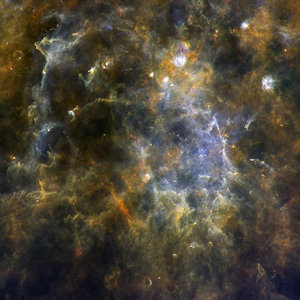
Chaotic web of filaments in a Milky Way stellar nursery
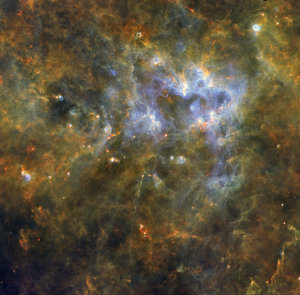
Hidden secrets of a massive star-formation region
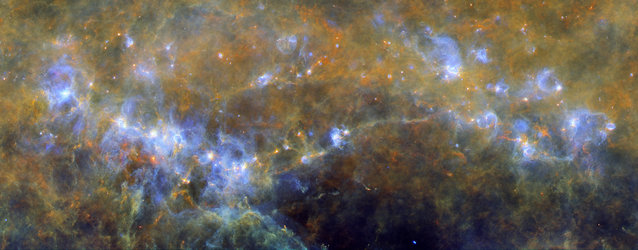
Star formation on filaments in RCW106
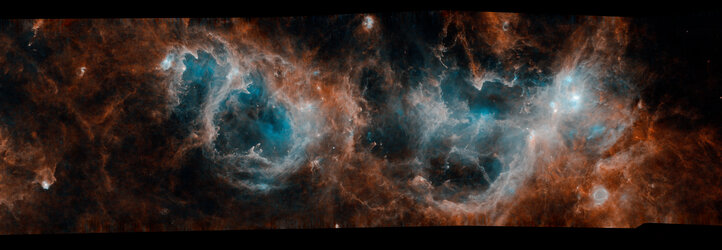
Herschel’s view of new stars and molecular clouds
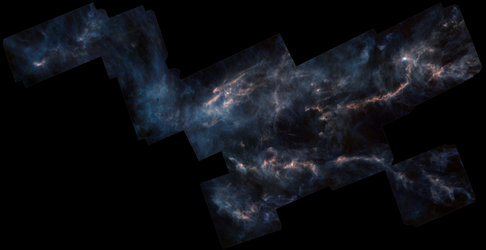














 Germany
Germany
 Austria
Austria
 Belgium
Belgium
 Denmark
Denmark
 Spain
Spain
 Estonia
Estonia
 Finland
Finland
 France
France
 Greece
Greece
 Hungary
Hungary
 Ireland
Ireland
 Italy
Italy
 Luxembourg
Luxembourg
 Norway
Norway
 The Netherlands
The Netherlands
 Poland
Poland
 Portugal
Portugal
 Czechia
Czechia
 Romania
Romania
 United Kingdom
United Kingdom
 Slovenia
Slovenia
 Sweden
Sweden
 Switzerland
Switzerland

























